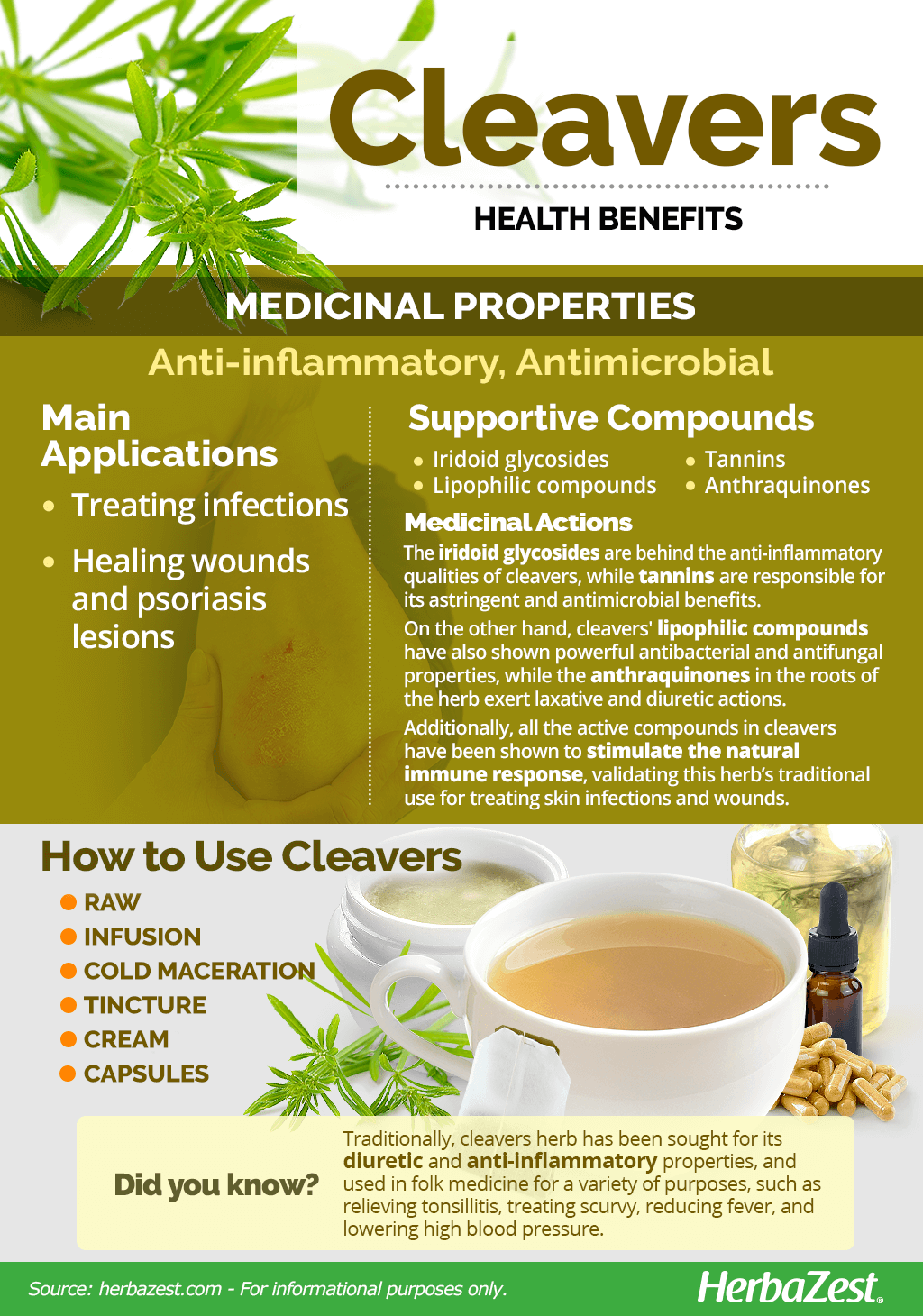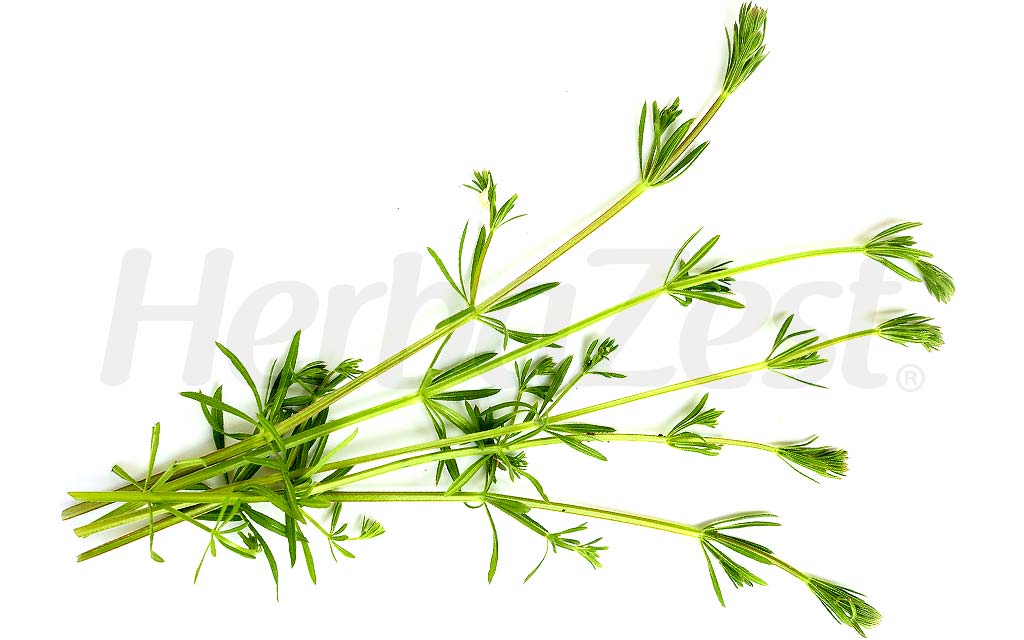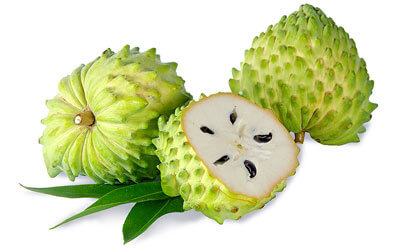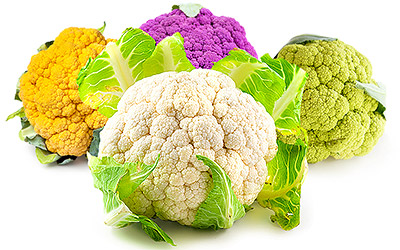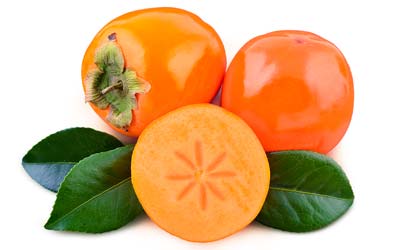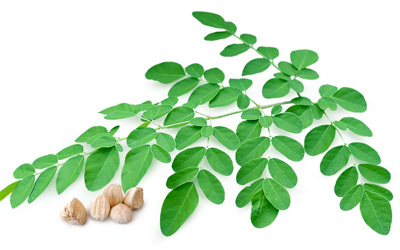Cleavers is common in various parts of the world, especially in North Africa, Southern Africa, and Asia. Often considered a garden nuisance, cleavers has an interesting set of medicinal properties, which have been used to treat many illnesses since ancient times.
Cleavers Medicinal Properties
- Medicinal action Anti-inflammatory, Antimicrobial
- Key constituents iridoid glycosides, tannins, lipophilic compounds, anthraquinones
- Ways to use Capsules, Cold infusions, Hot infusions/tisanes, Food, Juiced, Tincture, Ointment
- Medicinal rating (2) Minorly useful plant
- Safety ranking Use with caution
Health Benefits of Cleavers
Cleavers boast several medicinal benefits, with its antibacterial and astringent actions being the most remarkable ones. They are mainly used for:
Treating infections. Cleavers has shown strong antimicrobial properties, and it is popularly used in the treatment of sepsis as well as for respiratory illnesses and urinary tract infections (UTIs).
Healing wounds and psoriasis lesions. Cleavers has been traditionally used to treat a variety of skin ailments, light wounds, and burns.
Traditionally, cleavers has been sought for its diuretic and anti-inflammatory properties, and used in folk medicine for a variety of purposes, such as relieving tonsillitis, treating scurvy, reducing fever, and lowering high blood pressure.
How It Works
As most of the uses of cleavers are based on traditional practices rather than pharmacological studies of standardized Galium extracts, its mechanism of action is not fully understood. However, sesquiterpenoids, aromatic compounds, fatty acids, chlorophylls and carotenoids, among others, have been identified in cleavers.1
The two most significant substances behind cleavers' benefits are iridoid glycosides and tannins. While the former are related to the anti-inflammatory qualities of the plant, the latter are responsible for its astringent and antimicrobial benefits.1,2
In addition, the lipophilic compounds in cleavers have also shown powerful antibacterial and antifungal properties, while its roots contain various anthraquinones with laxative and diuretic effects.2
All active compounds in cleavers have been shown to stimulate the immune response, validating its traditional use for the treatment of skin infections and wounds.2
Honeysuckle and uva ursi are also herbs with strong antimicrobial properties, and similar anti-inflammatory benefits can be found in herbs like marsh mallow and jojoba.
Cleavers Side Effects
Cleaver is likely safe for most people. There are no reported side effects, although the cooling action of this herb, when consumed by mouth, can reduce body temperature and cause chilling.
Cautions
Diabetic patients taking prescribed medication should be cautious when using cleavers since its diuretic properties can further lower sugar levels.
Cleavers should be handled carefully because of its hairy leaves, which can produce skin irritation or contact dermatitis.

How to Consume Cleavers
The most effective way to consume cleavers is in the form of remedies, which concentrate all the beneficial properties of this herb. Cleavers can be applied both topically and internally. The alimentary uses of cleavers are mainly centered on salads and juices.
Natural Foods
Raw. A way to take advantage of cleavers' diuretic properties is to add its fresh leaves to salads and juices. For these purposes, the plant must be harvested during mid-winter or at the latest of it, because afterwards the leaves will turn tough and hairy.
Infusion. Dry leaves can be mixed with boiling water to brew a warm, herbal beverage. This simple remedy can help treat respiratory illnesses and urinary tract infections (UTIs.)
- Cold maceration. Crushed cleavers leaves can be covered with water and let sit overnight. In this form, cleavers can be taken orally to reduce fever.
Herbal Remedies & Supplements
Tincture. Macerating cleavers leaves into an alcoholic solution concentrates the anti-inflammatory and antibacterial actions of the plant. Diluted in a glass of water, this herbal remedy is recommended for intestinal catarrh, as well as for irritations of mucous membranes.
Creams. This water-based preparation is easily absorbed and meant for external use only. Cleavers creams are commonly used to help heal wounds and treat skin conditions.
Capsules. They provide high concentrations of cleavers' active components in fixed doses and are easy to find, helping reap all the benefits of this plant.
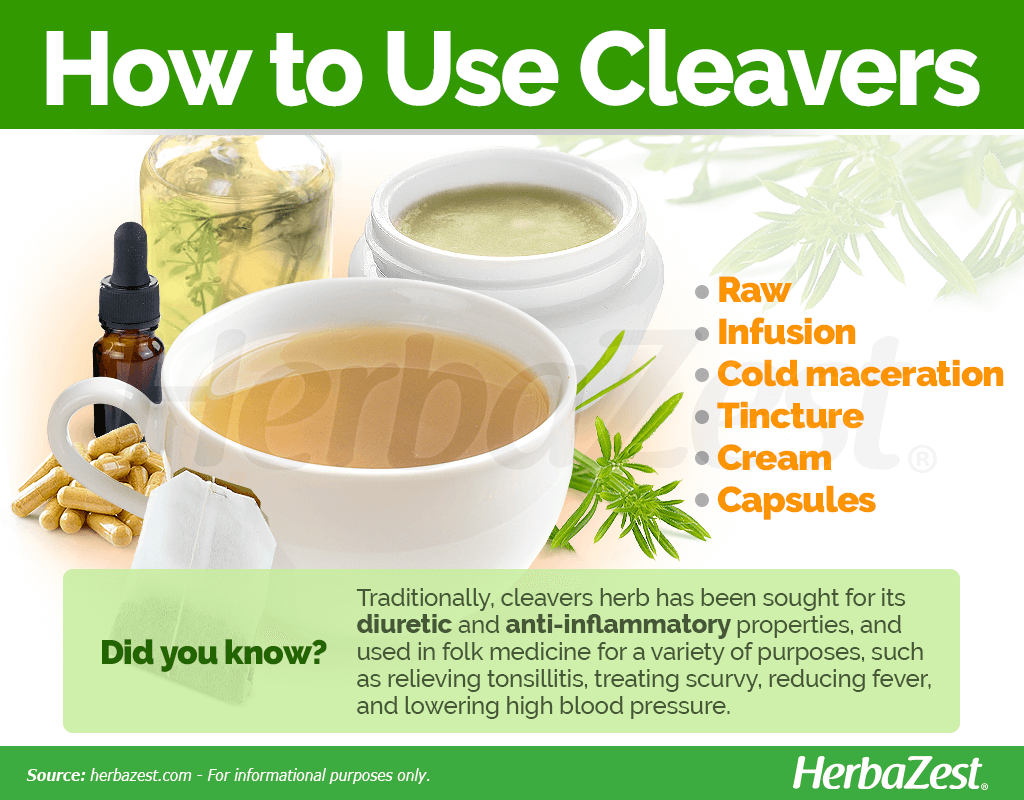
Growing
- Life cycle Annual
- Harvested parts Leaves
- Light requirements Full sun, Open shade, Full shade
- Soil Light (sandy), Medium (loam), Loamy sand
- Soil pH 5.1 – 5.5 (Strongly acidic), 5.6 – 6.0 (Moderately acidic), 6.1 – 6.5 (Slightly acidic), 6.6 – 7.3 (Neutral), 7.4 – 7.8 (Slightly alkaline)
- Growing habitat Temperate climates
- Pre-germination seed treatment None
- Planting time Right after last frost
- Growing time 8 weeks
This weedy species is an annual that can be grown in temperate regions, in parts of the garden managed for wildlife, as either a summer or winter annual (or occasionally as a biennial). The seed is thought to be viable for around 2 - 6 years unless frozen.
The creeping, climbing cleavers herb is commonly found in grassy areas and spreads rapidly. It can be an invasive plant and out-compete indigenous species. When cultivating it, care should be taken to prevent its spread into farmland or sensitive areas of conservation importance.
Growing Guidelines
Cleaver is reproduced by seeds.
It prefers moist soil, preferably a rich loam, with above-average fertility and pH of 5.5-8.0.
Seeds must be buried to germinate, ideally at a depth of 0.1 - 0.3 inches (2 - 10 mm).
Flowers appearing as soon as eight weeks after germination.
Ripe seeds develop from summer through autumn, depending on the region.
Supports – such as pea sticks - can be provided as this plant likes to climb.
Plants will die down after their hairy fruits are released. At that point, seeds must be collected to be sown for the next year.
Additional Information
- Other uses Basketry
Plant Biology
Cleavers is a prolific, climbing annual plant, commonly regarded as a weed and also known as bedstraw, catchweed, goosegrass and sticky willy, among other popular names. Many gardeners try to remove it rather than encourage the plant's growth in their gardens. It can also be found growing wild on roadsides, as well as in moist and grassy areas.
The stem of this plant can reach up to six feet (1.8 m) long, and it bears leaves that grow in whorls. The names "catchweed" and "sticky willy" refer to the fact that the hooked prickles on the leaves and fruits give the plant a "velcro-like" property. Cleavers plants send up bright green shoots from January onwards and produce white, four-petalled flowers in summer.
Classification
A member of Rubiaceae, or the madder family, Galium aparine is one of around 580 known taxa belonging to this group, notably including coffee (Coffea arabica), cat's claw (Uncaria tomentosa), quinine (Cinchona officinalis), and
partridge berry (Mitchella repens).There are two closely related species of cleavers classified in the Galium genus, which share the same medicinal potential: G. odoratum (sweet woodruff) and G. verum (lady's bedstraw). They are very similar in appearance, except for the color of the flowers, which are yellow in lady's bedstraw.
Varieties and Subspecies of Cleaver
There are three main subspecies of Galium aparine: subsp. aparine, subsp. spurium, and subsp. tenerum. In addition, controversy remains regarding Galium aparine var. agreste, as some contemporary botanists believe it should be classified as its own subspecies rather than as a variety.
Historical Information
The history of cleavers stretches as far back as the Ancient Greeks, who consumed it to counter weariness, whereas country folks have used its creeping, straggling stems to make baskets or sieves.
Economic Data
Owing to the fact it is generally considered a weed, no cleavers market has been established. There is some economic worth in cleavers' supplements that can be purchased, but this affects only a small part of the herbal medicine industry, not big enough to produce any reliable economic figures.
Other Uses
- Fodder. Cleavers is popularly used to feed chickens.
Sources
- Journal of Ethnobiology and Ethnomedicine, Ethnobotanical appraisal and cultural values of medicinally important wild edible vegetables of Lesser Himalayas-Pakistan, 2013
- Royal Botanic Garden Edinburgh, Flora Europaea, Galium aparine
- University of Michigan Health, Cleavers
- USDA Plants Database, Galium aparine L. stickywilly
- Encyclopedia of Herbal Medicine, pp. 213-214
- Medicinal Plants of the World, p. 152
- The Herb Book, pp. 108-110, 481
- Rosemary Gladstar's Herbal Recipes for Vibrant Health, pp. 100-105, 324
- Kew Royal Botanic Gardens, Galium aparine (cleavers)
Footnotes:
- The Pharma Innovation Journal. (2014). Phytochemical research of Galium aparine L. Lipophilic complex and study of its antibacterial activity. Retrieved January 2, 2024, from: https://www.thepharmajournal.com/archives/?year=2014&vol=3&issue=1&ArticleId=303
- Molecules. (2020). Immunomodulatory Activity and Phytochemical Profile of Infusions from Cleavers Herb. Retrieved January 2, 2024, from: https://www.ncbi.nlm.nih.gov/pmc/articles/PMC7464609/
